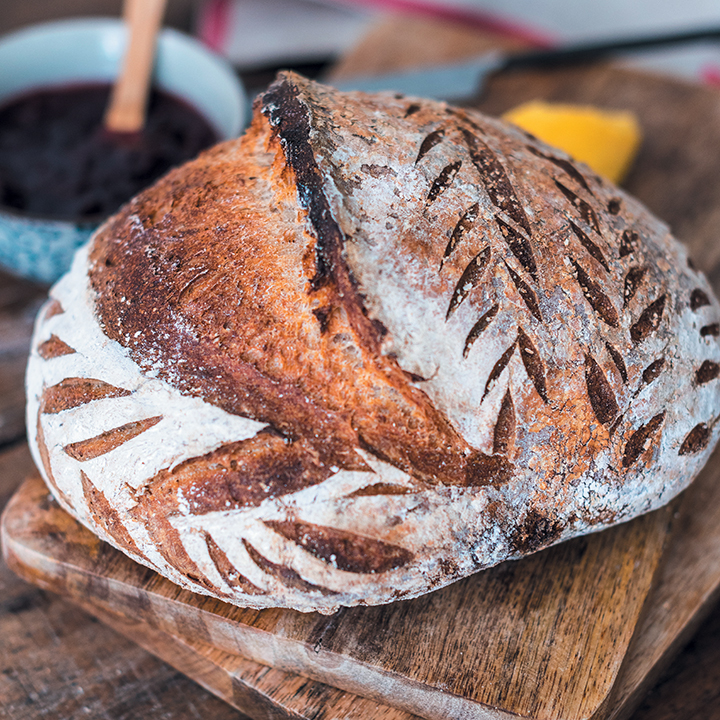This is a starter/home-made yeast for sourdough bread and while it should suffice for making any bread, not just sourdough… you can also make pancakes, muffins, waffles and pizza dough with this.
Sourdough refers to both bread and the starter used to make it. A sourdough starter begins with a combination of flour and liquid.
The proportion, and type, of flour and liquid can vary dramatically – from a stiff starter made entirely with rye flour and water to a liquid batter of milk and cornflour, and everything in between.
Friendly bacteria (lactobacilli), which is present in our natural environment, and the wild yeast attracted to (and living on) flour start to interact with one another when flour is mixed with warm water.
The result: a sourdough starter.
These tiny living creatures (lactobacilli and yeast; collectively called the sourdough’s microflora) generate byproducts that cause bread to rise and lend it its multifaceted, rich flavour.
Lactobacilli break down the complex carbohydrates in the flour into simple sugars – exactly what the yeast needs as food.
The yeast, feeding on these simple sugars, produces carbon dioxide bubbles.
The elastic wheat gluten in bread dough traps these carbon dioxide bubbles, causing the dough to expand, as if it contained a million tiny balloons.
WHAT YOU NEED
Time, patience, a mixing bowl, proving basket and dough cutter/knife.
Please note: while proper rattan proving baskets are available at kitchenware stores, Ciska made a DIY plan: she uses a bowl lined with a clean cloth dusted with cornflour or, for a longer shaped loaf, she uses the slots of an industrial kitchen cutlery tray lined with a clean cloth dusted with cornflour – home bakers can improvise with a rectangular container of 27cm long x 11cm wide x 10cm deep, or larger.
STARTER
250g wholewheat flour + 350g, to feed in daily batches of 50g x 7 days
250g white bread flour + 350g, to feed in daily batches of 50g x 7 days 500g water + 700g, to feed in daily batches of 100g x 7 days (for purposes of accuracy, bakers weigh liquids in grams, not millilitres)
HOW TO DO IT
Combine 250g wholewheat flour, 250g white bread flour and 500g water in a large container of your choice. Mix well to incorporate, and cover the container with a clean cloth and an elastic band to protect it from dust, but still allowing it to breathe. To feed your starter daily, remove 200g of the starter and discard, then add 50g wholewheat flour, 50g white bread flour and 100g water to the container with the starter, and stir to combine well. Repeat the feeding process every day. It will take roughly about 7 days for the yeast to become adequately active.
To test if your starter is active, do the floatation test: place a tablespoonful of your starter in a little water. If the starter sinks to the bottom, it is not yet active enough. If the starter floats on top of the water, though, it is active and ready to bake.
BAKER’S TIP
Discarding a part of your sourdough starter as it “grows” is important for two reasons: firstly, by keeping the starter volume at the same level, you manage to keep the pH level more steady. Secondly, by not growing the volume of the starter, you manage the food intake of the yeast. In so doing, the yeast will all have ample food and won’t have to fight for it. You could also always give some to a friend.
READ MORE: The ultimate starter “101” guide – all your questions answered
WHY CHOOSE SOURDOUGH?
- Sourdough is delicious and its distinctive, pleasantly sour twang is alluring. Packed with probiotics and being partially fermented, it’s good for the gut. Sourdough retards starch digestibility, leading to low glycaemic responses (giving you sustained energy and better blood glucose- and appetite control), modulates levels and bio-accessibility of bio-active compounds (phytochemicals) and improves bio-availability of minerals from the grains.
- The key is the type of flour used, the fermentation process and the absence of the long list of additives typical of commercially produced bread. Ciska uses stoneground, unbleached flour without any additives.
- Sourdough naturally has a longer shelf life and the flavour improves over time.
MASTERCLASS BY CISKA ROSSOUW
ASSISTED BY COSTANTINE KONDO
PHOTOGRAPHS BY HEIN VAN TONDER





